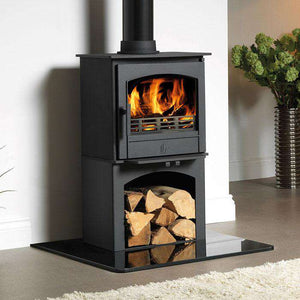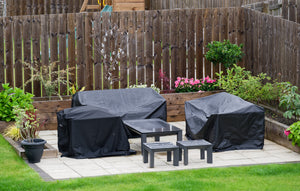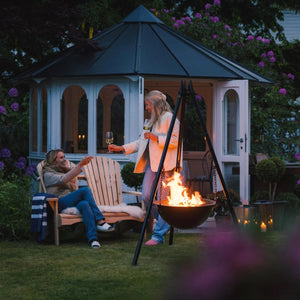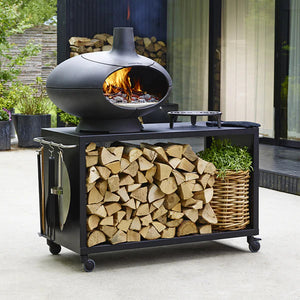What's best for me? A stove or an open fire?
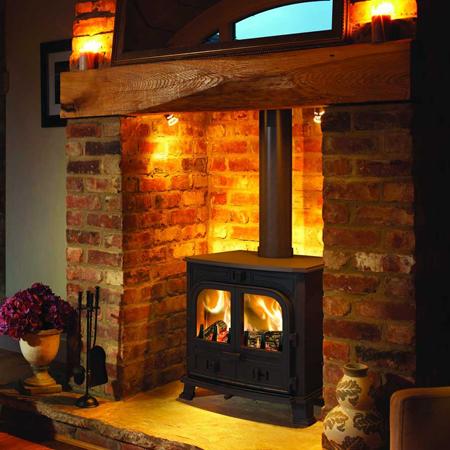
The chillier the evenings become, the fierier the debate rages. Which is best, a roaring open fire or a warming wood burning stove? And more importantly, which is best for you?
Much will depend on whether you’re a traditionalist or have more contemporary tastes.
You may prefer the dancing flames of a crackling open fire. Or you may be eyeing up a wood burning stove to become the cosy yet modern centrepiece of your home.
Whatever your thoughts, ponder the four decision-influencing factors which follow before deciding whether a stove or an open fire is the perfect choice for you and your home.
A wood burning stove is a closed appliance. Air intake is controllable which determines how quickly the fuel burns and so how much warmth is emitted. You still need a chimney or flue for waste gases.
The efficiency of an open fire will vary enormously. Typically, this may be around 15% but it can be as low as 5%, rising to 35%.
Wood burning stoves are very efficient. Individual stoves must be able to achieve an efficiency of 65% according to British Standards. Modern wood burning stoves average around 80% efficiency with some exceeding 95%.
That means the running costs associated with a stove are significantly lower than that of an open fire.
With a stove, the flame is encased in a cast iron or steel casing with a toughened glass frontage.
An open fire has no particular integrated safety features but you can position a spark / fire guard in front to prevent sparks and embers spitting out. Spark guards are available in a vast range of sizes and styles.
You should note that chimney fires caused by stoves are actually more common than those from open fires. However, this is as a result of how the stove is operated rather than the appliance itself. Overregulating the air supply or burning wet wood in a stove increases the risk of a chimney fire.
The cost to install a stove is usually higher than that of an open fire. This is because the chimney will have to have a suitable and appropriate form of lining fitted to it.
A stove emits a controlled burn for efficiency. This isn't quite the same as a blazing fire, and a stove won’t produce the same amount of heat at any one time. With a stove, you won’t get that blast of heat after a chilly winter walk.
Open fires have a romantic and homely appeal, a rich aroma, and provide a soothing ambience. That said, wood burning stoves can be stunning standout features in their own right and individually chosen to match your chosen décor.
Over to you…
Whether an open fire or a wood burning stove is best for you entirely comes down to personal taste and your own thoughts as to what is important.
You should also consider how you intend to manage the flaming focal point at the heart of your home and how cost-effective you want your chosen heat source to be. It really is over to you, and your imagination!
Much will depend on whether you’re a traditionalist or have more contemporary tastes.
You may prefer the dancing flames of a crackling open fire. Or you may be eyeing up a wood burning stove to become the cosy yet modern centrepiece of your home.
Whatever your thoughts, ponder the four decision-influencing factors which follow before deciding whether a stove or an open fire is the perfect choice for you and your home.
What is the difference between an open fire and a stove?
To keep things simple, an open fire is just that - a fire which sits within a grate above or below a chimney or flue. The more fuel you pile up, the more heat will be generated.A wood burning stove is a closed appliance. Air intake is controllable which determines how quickly the fuel burns and so how much warmth is emitted. You still need a chimney or flue for waste gases.
Best for efficiency
Heat efficiency is essentially the amount of heat generated in return from the fuel consumed.The efficiency of an open fire will vary enormously. Typically, this may be around 15% but it can be as low as 5%, rising to 35%.
Wood burning stoves are very efficient. Individual stoves must be able to achieve an efficiency of 65% according to British Standards. Modern wood burning stoves average around 80% efficiency with some exceeding 95%.
That means the running costs associated with a stove are significantly lower than that of an open fire.
Best for safety
With a stove, the flame is encased in a cast iron or steel casing with a toughened glass frontage.An open fire has no particular integrated safety features but you can position a spark / fire guard in front to prevent sparks and embers spitting out. Spark guards are available in a vast range of sizes and styles.
You should note that chimney fires caused by stoves are actually more common than those from open fires. However, this is as a result of how the stove is operated rather than the appliance itself. Overregulating the air supply or burning wet wood in a stove increases the risk of a chimney fire.
Cost to install
The cost to install a stove is usually higher than that of an open fire. This is because the chimney will have to have a suitable and appropriate form of lining fitted to it.Best for aesthetics
This is a matter of personal taste, and the individual style of your home and the room in which the heat source is installed, but the crackle and roar of an open fire is hard to resist.A stove emits a controlled burn for efficiency. This isn't quite the same as a blazing fire, and a stove won’t produce the same amount of heat at any one time. With a stove, you won’t get that blast of heat after a chilly winter walk.
Open fires have a romantic and homely appeal, a rich aroma, and provide a soothing ambience. That said, wood burning stoves can be stunning standout features in their own right and individually chosen to match your chosen décor.
Over to you…
Whether an open fire or a wood burning stove is best for you entirely comes down to personal taste and your own thoughts as to what is important.
You should also consider how you intend to manage the flaming focal point at the heart of your home and how cost-effective you want your chosen heat source to be. It really is over to you, and your imagination!
Have a browse on our website here for your perfect stove or get in touch; give us a call on 01226 816 051 or send us an email at sales@stovesupermarket.co.uk.
- Stovesupermarket Admin



